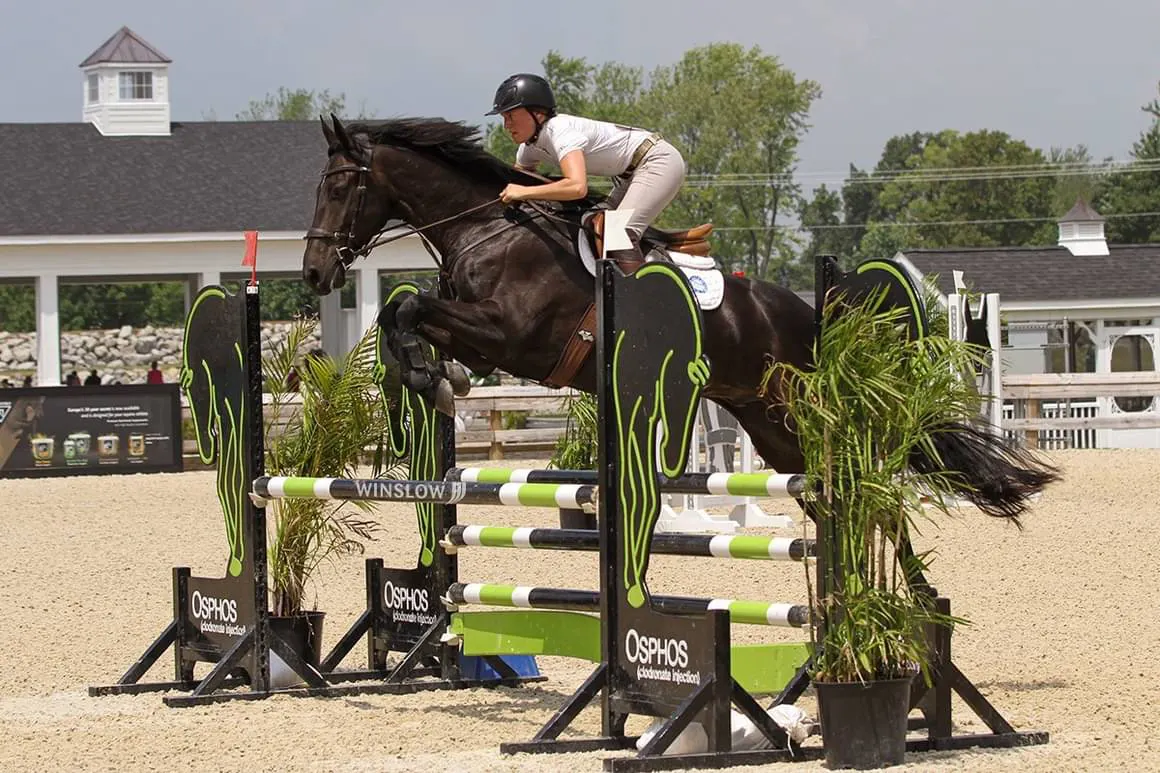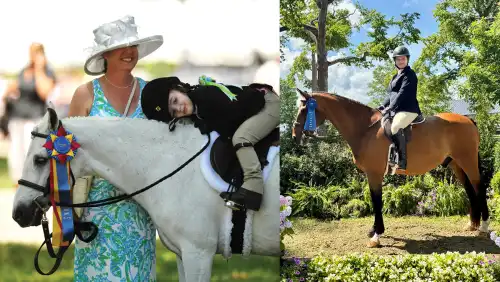I was interviewing a top U.S. show jumping team rider recently, and I asked about the challenges of competing for young riders who don’t have affluent parents or connections in the industry. They said something that really rubbed me the wrong way—they said a lot of people use money and lack of wealth as an excuse for why they can’t find a way to make it in this sport, but all people have all kinds of challenges, be they the mental challenges of competing under pressure, physical limitations or a smaller budget, and you just have to “get creative,” “work hard” and “not make excuses.”
I didn’t say anything—it’s not my place to express my opinion on the subject during an interview—but in the weeks that followed the comment kept popping up in my head: Excuses. “Get creative.” Work harder.
I started thinking about my own riding life, and the last time I really tried to compete and go to horse shows semi-regularly, which was during the four years after undergrad when I was living in Lexington, Kentucky, and working full time for the Chronicle. I bought a 2-year-old horse and did most of the training on him myself. I field boarded him and handled all his care. During the winter show season I’d clean stalls at 5 a.m. for extra cash before my day started at the Chronicle. I’d use some of my vacation days to go work 12-hour shifts for a horse show photographer. I bought a cheap horse trailer and rented a U-Haul truck to haul myself to shows. I slept in a hammock in the grooming stall to avoid paying for a hotel. I was never in anything close to full training, or even regular weekly lessons, but I hauled to a trainer occasionally and did whatever I could to work off the lesson bill. Even so, I had no savings account to speak of. Every dollar that came in went out, to rent, groceries, gas and horse shows.

I could have switched sports. I could have started eventing. It would be more affordable, but it’s just not the sport that captured my heart as a kid. I have no real interest in dressage, and I don’t love the thought of jumping solid obstacles past a certain height.
I think of my friends and the ways we all tried to “get creative” over the years and be a part of this sport. My friend Erin Gilmore, one of the best equine journalists and photographers in the business, was able to own a scopey, well-bred warmblood only because his behavioral issues had gotten so bad that his previous owner signed him over to Erin for a dollar. She spent years patiently retraining him to get past those issues, all while working insane hours covering horse shows. While she was largely successful in rehabilitating him, his issues still cropped up occasionally, which often meant the horse shows she had worked so hard to pay for didn’t go as planned.
I think of Katie Reck, who was my trainer when I was a kid and is now a dear friend. She started out as a small-town pony clubber in Iowa and worked hard to grow her business to the point she was based in Florida and competing at major horse shows around the country at the FEI level and had rides on several grand prix horses. She broke her leg in a riding accident in Germany, and with no family connections in the sport or wealth to fall back on while she recuperated, it became very clear to her what a fair-weather friend a professional riding career is.
ADVERTISEMENT
When I stopped working at the Chronicle and moved to Madison, Wisconsin, to go to law school, it was the first time I took a break from showing since I was a kid. I field boarded my horse at a nearby facility and rode when I could, which was sometimes quite infrequently during hectic periods of law school. Sometimes we worked in the ring and over fences, but mostly we went on trail rides through the woods or trotted down the road past the corn and bean fields, and I just enjoyed being out in the fresh air on a horse instead of hunched over a book at my desk. I figured when I graduated law school and started getting a paycheck again, I would go back to showing, but that didn’t happen.
Something clicked when I took that step back during law school, and I realized I simply no longer had any interest in living on a financial razor’s edge and working like a dog just to be allowed to occasionally compete in the sport I love. I’ll be perfectly transparent about the math: After graduation I looked at my salary, which is $72,000, and subtracted my rent on a one-bedroom apartment ($1,295), utilities ($139), and field board for my horse ($250) from my base monthly take home pay. I was left with $2,106 of disposable income for the month.
Something clicked when I took that step back during law school, and I realized I simply no longer had any interest in living on a financial razor’s edge and working like a dog just to be allowed to occasionally compete in the sport I love.
I then looked at the prize list for my nearest rated horse show (Ledges in Illinois, 59 miles from Madison), and calculated what it would cost to show one horse in the low child/adult jumpers for a weekend. Between what I would pay to the horse show ($818), a shipper ($147), a trainer ($400), and a hotel ($225 for three nights at the Quality Inn), the total would come to $1,590. That would leave me with $516 dollars to get through an entire month of groceries, gas, dog food—or, god forbid, a car repair, vet bill or doctor’s appointment. That doesn’t include a single lesson at home before going to the horse show, and I am well aware that $250 is an insanely good deal for board (and it includes 24/7 access to hay). Forget about savings; even if I ate peanut butter sandwiches and instant ramen, there wouldn’t be anything left over at the end of the month.
According to the U.S. Bureau of Labor Statistics, the average salary for a single person as of 2022 was $60,575, with a median income of $56,420. So at $72,000 I’m comfortably above the average and well above the median, and even so it would be nearly impossible—or at the very least incredibly financially irresponsible—for me to compete just once a month on a single horse, in a single division, at the closest rated horse show.
All that means it leaves a bad taste in my mouth when people competing at the top level in this sport see no problem telling people they either need to be wealthy or “get creative” and be willing to work multiple jobs and be left with no money to save or time to spend doing anything else, just to compete extremely modestly in this sport.
ADVERTISEMENT
I’m simply at a place in my life where I’m not willing to do that anymore. I want to have a savings account. I want to have the time and money to spend going dancing with my friends and making a nice dinner for my partner. My dad wants me to run a half marathon with him, I want to have the time to train for that.
I can still enjoy my horse and the sport I love without going to rated competitions. I will always love the challenge of trying to successfully navigate a course of fences—which I can do myself at home or at local schooling shows—and I still occasionally watch the live streams of top competitions.

It makes me smile that my friends and I have found new ways we never would have imagined to enjoy ourselves and our time spent with horses. These days, Katie is a realtor (turns out the skills required to sell high-dollar horses are great prep for selling houses). She no longer owns any show jumpers, but still goes trail riding with our old farrier, Cody Roller, and has recently bought a cutting horse to start causally dipping her toe into that competitive world. Erin retired her warmblood and bought a beautiful, safe and sane 4-year-old palomino Vanner cross. She has tried all kinds of things with him—some western stuff, trail obstacles and more recently they’ve gotten into eventing, completing several beginner novice events.
Katie and I recently got the wild idea to try to go camping in Wisconsin with our horses (a first for us both), and it was an absolute blast. We rode seven miles on a beautiful trail through the woods and across streams with a stop at a local bar (complete with a hitching post to park your horse at), and we laughed and laughed about all the crazy situations we’d gotten ourselves into over the years at horse shows trying to save a buck. All three of us agree we can’t believe how many years we spent forking over huge portions of our income to horse shows, and we can’t imagine ever doing that again. I still believe the rated levels of this sport could be accessible if the people at the top of the sport and its governing body had any real interest in trying to make that happen, but they don’t, and I’m going to hold my breath waiting for that to change.
So to the rider who thinks people like me, Katie and Erin are simply not “working hard enough,” or need to “get creative,” I shake my head and raise a beer in the spirit of “agree to disagree” from the trails of Wisconsin. We did get creative: After years spent in a community that time and again told us it could care less whether we were able to be a part of it, we came up with our own ways to stay connected to these incredible animals we all love and still live a full life.
Ann Glavan is a staff attorney for the Dane County Circuit Court in Madison, Wisconsin. Before becoming an attorney Ann spent four years working full time for The Chronicle of the Horse. She has no plans to compete her adult jumper, Moji, any time soon, but if you’re out on the Midwest trails and see a big black horse with a Modelo-swigging rider, say hi.














